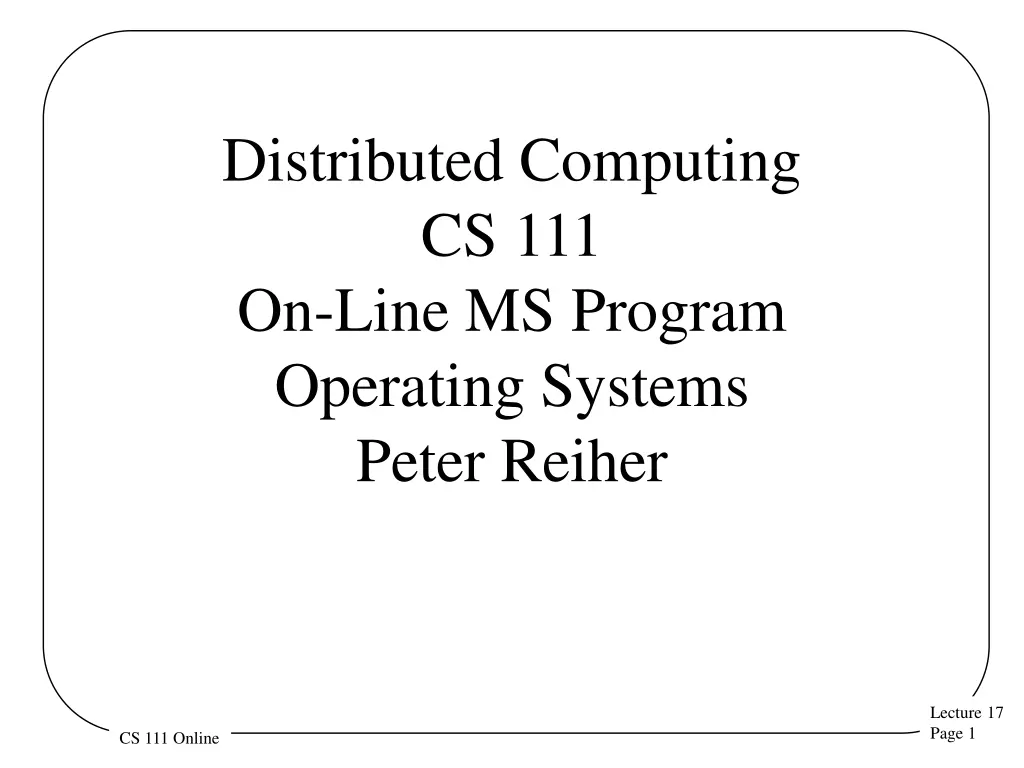
Distributed Computing Goals & Characteristics
Explore the goals and characteristics of distributed computing, focusing on scalability, availability, ease of use, and system configuration. Delve into tightly and loosely coupled systems, global coherence, and achieving consistent views in distributed setups.
Download Presentation

Please find below an Image/Link to download the presentation.
The content on the website is provided AS IS for your information and personal use only. It may not be sold, licensed, or shared on other websites without obtaining consent from the author. If you encounter any issues during the download, it is possible that the publisher has removed the file from their server.
You are allowed to download the files provided on this website for personal or commercial use, subject to the condition that they are used lawfully. All files are the property of their respective owners.
The content on the website is provided AS IS for your information and personal use only. It may not be sold, licensed, or shared on other websites without obtaining consent from the author.
E N D
Presentation Transcript
Distributed Computing CS 111 On-Line MS Program Operating Systems Peter Reiher Lecture 17 Page 1 CS 111 Online
Outline Goals and vision of distributed computing Basic architectures Symmetric multiprocessors Single system image distributed systems Cloud computing systems User-level distributed computing Lecture 17 Page 2 CS 111 Online
Goals of Distributed Computing Better services Scalability Some applications require more resources than one computer has Should be able to grow system capacity to meet growing demand Availability Disks, computers, and software fail, but services should be 24x7! Improved ease of use, with reduced operating expenses Ensuring correct configuration of all services on all systems New services Applications that span multiple system boundaries Global resource domains, services decoupled from systems Complete location transparency Lecture 17 Page 3 CS 111 Online
Important Characteristics of Distributed Systems Performance Overhead, scalability, availability Functionality Adequacy and abstraction for target applications Transparency Compatibility with previous platforms Scope and degree of location independence Degree of coupling How many things do distinct systems agree on? How is that agreement achieved? Lecture 17 Page 4 CS 111 Online
Loosely and Tightly Coupled Systems Tightly coupled systems Share a global pool of resources Agree on their state, coordinate their actions Loosely coupled systems Have independent resources Only coordinate actions in special circumstances Degree of coupling Tight coupling: global coherent view, seamless fail-over But very difficult to do right Loose coupling: simple and highly scalable But a less pleasant system model Lecture 17 Page 5 CS 111 Online
Globally Coherent Views Everyone sees the same thing Usually the case on single machines Harder to achieve in distributed systems How to achieve it? Have only one copy of things that need single view Limits the benefits of the distributed system And exaggerates some of their costs Ensure multiple copies are consistent Requiring complex and expensive consensus protocols Not much of a choice Lecture 17 Page 6 CS 111 Online
Major Classes of Distributed Systems Symmetric Multi-Processors (SMP) Multiple CPUs, sharing memory and I/O devices Single-System Image (SSI) & Cluster Computing A group of computers, acting like a single computer Loosely coupled, horizontally scalable systems Coordinated, but relatively independent systems Cloud computing is the most widely used version Application level distributed computing Application level protocols Distributed middle-ware platforms Lecture 17 Page 7 CS 111 Online
Symmetric Multiprocessors (SMP) What are they and what are their goals? SMP price/performance OS design for SMP systems SMP parallelism The memory bandwidth problem Non-Uniform Memory Architectures (NUMA) Lecture 17 Page 8 CS 111 Online
SMP Systems Computers composed of multiple identical compute engines Each computer in SMP system usually called a node Sharing memories and devices Could run same or different code on all nodes Each node runs at its own pace Though resource contention can cause nodes to block Examples: BBN Butterfly parallel processor More recently, multi-way Intel servers Lecture 17 Page 9 CS 111 Online
SMP Goals Price performance Lower price per MIP than single machine Scalability Economical way to build huge systems Possibility of increasing machine s power just by adding more nodes Perfect application transparency Runs the same on 16 nodes as on one Except faster Lecture 17 Page 10 CS 111 Online
A Typical SMP Architecture CPU 1 CPU 2 CPU 3 CPU 4 interrupt controller cache cache cache cache shared memory & device busses device controller device controller device controller memory Lecture 17 Page 11 CS 111 Online
The SMP Price/Performance Argument A computer is much more than a CPU Mother-board, disks, controllers, power supplies, case CPU might cost 10-15% of the cost of the computer Adding CPUs to a computer is very cost-effective A second CPU yields cost of 1.1x, performance 1.9x A third CPU yields cost of 1.2x, performance 2.7x Same argument also applies at the chip level Making a machine twice as fast is ever more difficult Adding more cores to the chip gets ever easier Massive multi-processors are an obvious direction Lecture 17 Page 12 CS 111 Online
SMP Operating Systems One processor boots with power on It controls the starting of all other processors Same OS code runs in all processors One physical copy in memory, shared by all CPUs Each CPU has its own registers, cache, MMU They cooperatively share memory and devices ALL kernel operations must be Multi-Thread- Safe Protected by appropriate locks/semaphores Very fine grained locking to avoid contention Lecture 17 Page 13 CS 111 Online
Handling Kernel Synchronization Multiple processors are sharing one OS copy What needs to be synchronized? Every potentially sharable OS data structure Process descriptors, file descriptors, data buffers, message queues, etc. All of the devices Could we just lock the entire kernel, instead? Yes, but it would be a bottleneck Remember lock contention? Avoidable by not using coarse-grained locking Lecture 17 Page 14 CS 111 Online
SMP Parallelism Scheduling and load sharing Each CPU can be running a different process Just take the next ready process off the run-queue Processes run in parallel Most processes don't interact (other than inside kernel) If they do, poor performance caused by excessive synchronization Serialization Mutual exclusion achieved by locks in shared memory Locks can be maintained with atomic instructions Spin locks acceptable for VERY short critical sections If a process blocks, that CPU finds next ready process Lecture 17 Page 15 CS 111 Online
The Challenge of SMP Performance Scalability depends on memory contention Memory bandwidth is limited, can't handle all CPUs Most references better be satisfied from per-CPU cache If too many requests go to memory, CPUs slow down Scalability depends on lock contention Waiting for spin-locks wastes time Context switches waiting for kernel locks waste time This contention wastes cycles, reduces throughput 2 CPUs might deliver only 1.9x performance 3 CPUs might deliver only 2.7x performance Lecture 17 Page 16 CS 111 Online
Managing Memory Contention Each processor has its own cache Cache reads don t cause memory contention Writes are more problematic Locality of reference often solves the problems Different processes write to different places Keeping everything coherent still requires a smart memory controller Fast n-way memory controllers are very expensive Without them, memory contention taxes performance Cost/complexity limits how many CPUs we can add Lecture 17 Page 17 CS 111 Online
NUMA Non-Uniform Memory Architectures Another approach to handling memory in SMPs Each CPU gets its own memory, which is on the bus Each CPU has fast path to its own memory Connected by a Scalable Coherent Interconnect A very fast, very local network between memories Accessing memory over the SCI may be 3-20x slower These interconnects can be highly scalable Lecture 17 Page 18 CS 111 Online
A Sample NUMA SMP Architecture CPU n CPU n+1 local memory local memory cache cache PCI bridge PCI bridge PCI bus PCI bus CC NUMA interface device controller device controller CC NUMA interface device controller device controller Scalable Coherent Interconnect Lecture 17 Page 19 CS 111 Online
OS Design for NUMA Systems All about local memory hit rates Each processor must use local memory almost exclusively Every outside reference costs us 3-20x performance We need 75-95% hit rate just to break even How can the OS ensure high hit-rates? Replicate shared code pages in each CPU s memory Assign processes to CPUs, allocate all memory there Migrate processes to achieve load balancing Spread kernel resources among all the CPUs Attempt to preferentially allocate local resources Migrate resource ownership to CPU that is using it Lecture 17 Page 20 CS 111 Online
The Key SMP Scaling Problem True shared memory is expensive for large numbers of processors NUMA systems require a high degree of system complexity to perform well Otherwise, they re always accessing remote memory at very high costs So there is a limit to the technology for both approaches Which explains why SMP is not ubiquitous Lecture 17 Page 21 CS 111 Online






















